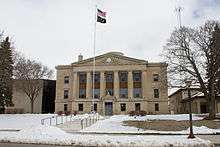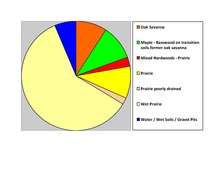Sibley County, Minnesota
| Sibley County, Minnesota | |
|---|---|
 Sibley County Courthouse | |
 Location in the U.S. state of Minnesota | |
 Minnesota's location in the U.S. | |
| Founded | March 5, 1853[1] |
| Named for | Henry Hastings Sibley[2] |
| Seat | Gaylord |
| Largest city | Gaylord |
| Area | |
| • Total | 601 sq mi (1,557 km2) |
| • Land | 589 sq mi (1,526 km2) |
| • Water | 12 sq mi (31 km2), 2.0% |
| Population (est.) | |
| • (2015) | 14,875 |
| • Density | 26/sq mi (10/km²) |
| Congressional district | 7th |
| Time zone | Central: UTC-6/-5 |
| Website |
www |
Sibley County is a county located in the U.S. state of Minnesota. As of the 2010 census, the population was 15,226.[3] Its county seat is Gaylord.[4] Sibley County is included in the Minneapolis-St. Paul-Bloomington, MN-WI Metropolitan Statistical Area.
Geography
According to the U.S. Census Bureau, the county has a total area of 601 square miles (1,560 km2), of which 589 square miles (1,530 km2) is land and 12 square miles (31 km2) (2.0%) is water.[5]

Most of the Rush River's watershed is located in Sibley County.
Lakes
- Altnow Lake: in Dryden Township
- Beatty Lake: in Dryden Township
- Clear Lake: northern half is in Severance Township; southern half is in Nicollet County
- Curran Lake: in Green Isle Township
- Hahn Lake: in New Auburn Township
- High Island Lake: in New Auburn Township
- Indian Lake: in Transit Township
- Kerry Lake: in Faxon Township
- Mud Lake: in Dryden Township
- Mud Lake: there is another Mud Lake in New Auburn Township northwest of Hahn Lake
- Mud Lake: there is a third Mud Lake in New Auburn Township southeast of Hahn Lake
- Mud Lake: there is a fourth Mud Lake in Severance Township
- Mud Lakes: three lakes in Washington Lake Township
- Sand Lake: western two thirds is in Cornish Township; the eastern third is in Alfsborg Township
- Schauer Lake: in Green Isle Township
- Schilling Lake: in New Auburn Township
- Severance Lake: in Green Isle Township
- Silver Lake: in Jessenland Township
- Swan Lake: in Severance Township
- Titlow Lake: in Dryden Township: the North Branch Rush River starts at this lake.
- Washington Lake: in Washington Lake Township
Major highways
.svg.png) U.S. Highway 169
U.S. Highway 169 Minnesota State Highway 5
Minnesota State Highway 5 Minnesota State Highway 15
Minnesota State Highway 15 Minnesota State Highway 19
Minnesota State Highway 19 Minnesota State Highway 22
Minnesota State Highway 22 Minnesota State Highway 25
Minnesota State Highway 25 Minnesota State Highway 93
Minnesota State Highway 93
Adjacent counties
- McLeod County (north)
- Carver County (northeast)
- Scott County (east)
- Le Sueur County (southeast)
- Nicollet County (south)
- Renville County (west)
Demographics
| Historical population | |||
|---|---|---|---|
| Census | Pop. | %± | |
| 1860 | 3,609 | — | |
| 1870 | 6,725 | 86.3% | |
| 1880 | 10,637 | 58.2% | |
| 1890 | 15,199 | 42.9% | |
| 1900 | 16,862 | 10.9% | |
| 1910 | 15,540 | −7.8% | |
| 1920 | 15,635 | 0.6% | |
| 1930 | 15,865 | 1.5% | |
| 1940 | 16,625 | 4.8% | |
| 1950 | 15,816 | −4.9% | |
| 1960 | 16,228 | 2.6% | |
| 1970 | 15,845 | −2.4% | |
| 1980 | 15,448 | −2.5% | |
| 1990 | 14,366 | −7.0% | |
| 2000 | 15,356 | 6.9% | |
| 2010 | 15,226 | −0.8% | |
| Est. 2015 | 14,875 | [7] | −2.3% |
| U.S. Decennial Census[8] 1790-1960[9] 1900-1990[10] 1990-2000[11] 2010-2015[3] | |||

As of the census of 2000,[12] there were 15,356 people, 5,772 households, and 4,086 families residing in the county. The population density was 26 people per square mile (10/km²). There were 6,024 housing units at an average density of 10 per square mile (4/km²). The racial makeup of the county was 95.57% White, 0.12% Black or African American, 0.26% Native American, 0.33% Asian, 3.09% from other races, and 0.62% from two or more races. 5.43% of the population were Hispanic or Latino of any race. 65.7% were of German and 6.3% Norwegian ancestry.
There were 5,772 households out of which 33.60% had children under the age of 18 living with them, 61.10% were married couples living together, 5.80% had a female householder with no husband present, and 29.20% were non-families. 25.40% of all households were made up of individuals and 13.00% had someone living alone who was 65 years of age or older. The average household size was 2.60 and the average family size was 3.14.
In the county the population was spread out with 27.70% under the age of 18, 7.50% from 18 to 24, 27.10% from 25 to 44, 21.30% from 45 to 64, and 16.40% who were 65 years of age or older. The median age was 37 years. For every 100 females there were 102.90 males. For every 100 females age 18 and over, there were 99.90 males.
The median income for a household in the county was $41,458, and the median income for a family was $48,923. Males had a median income of $31,002 versus $22,527 for females. The per capita income for the county was $18,004. About 5.10% of families and 8.10% of the population were below the poverty line, including 9.80% of those under age 18 and 7.80% of those age 65 or over.
Communities
Cities
- Arlington
- Gaylord (county seat)
- Gibbon
- Green Isle
- Henderson
- Le Sueur mostly in Le Sueur County)
- New Auburn
- Winthrop
Townships
- Alfsborg Township
- Arlington Township
- Bismarck Township
- Cornish Township
- Dryden Township
- Faxon Township
- Grafton Township
- Green Isle Township
- Henderson Township
- Jessenland Township
- Kelso Township
- Moltke Township
- New Auburn Township
- Severance Township
- Sibley Township
- Transit Township
- Washington Lake Township
Unincorporated communities
- Assumption (partial)
- New Rome
- Rush River
See also
References
- ↑ "Minnesota Place Names". Minnesota Historical Society. Retrieved March 19, 2014.
- ↑ Upham, Warren (1920). Minnesota Geographic Names: Their Origin and Historic Significance. Minnesota Historical Society. p. 518.
- 1 2 "State & County QuickFacts". United States Census Bureau. Retrieved September 1, 2013.
- ↑ "Find a County". National Association of Counties. Archived from the original on May 31, 2011. Retrieved 2011-06-07.
- ↑ "2010 Census Gazetteer Files". United States Census Bureau. August 22, 2012. Retrieved October 25, 2014.
- ↑ Nelson, Steven (2011). Savanna Soils of Minnesota. Minnesota: Self. pp. 65 - 67. ISBN 978-0-615-50320-2.
- ↑ "County Totals Dataset: Population, Population Change and Estimated Components of Population Change: April 1, 2010 to July 1, 2015". Retrieved July 2, 2016.
- ↑ "U.S. Decennial Census". United States Census Bureau. Archived from the original on May 11, 2015. Retrieved October 25, 2014.
- ↑ "Historical Census Browser". University of Virginia Library. Retrieved October 25, 2014.
- ↑ "Population of Counties by Decennial Census: 1900 to 1990". United States Census Bureau. Retrieved October 25, 2014.
- ↑ "Census 2000 PHC-T-4. Ranking Tables for Counties: 1990 and 2000" (PDF). United States Census Bureau. Retrieved October 25, 2014.
- ↑ "American FactFinder". United States Census Bureau. Retrieved 2008-01-31.
External links
 |
Renville County | McLeod County | Carver County |  |
| Renville County | |
Scott County | ||
| ||||
| | ||||
| Nicollet County | Le Sueur County |
Coordinates: 44°35′N 94°14′W / 44.58°N 94.23°W